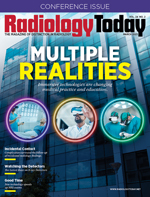 Editor’s Note: New Views
Editor’s Note: New Views
By David Yeager
Radiology Today
Vol. 24 No. 2 P. 4
Have you ever looked at something you’ve seen a thousand times and seen it in a new way? It may be a picture on your wall or the view from your back porch, but something seems different. Advances in medical imaging can have this effect, allowing radiologists and other physicians to see familiar images in new ways. In this month’s issue, we’re highlighting advances that are allowing people to gather more imaging insight.
Our cover feature looks at the burgeoning use of immersive technologies—$2.5 billion in market value, according to one report—in health care, including radiology, patient care, and physician education. In speaking with people who are at the forefront of augmented and virtual—together referred to as mixed—reality use cases, Claudia Stahl outlines some of the exciting possibilities that lie ahead. Mixed realty’s utility in performing minimally invasive procedures is only beginning to show its potential, and its enhancement of surgical planning, physician collaboration, and physician education has been well documented, including in this magazine. Perhaps its most notable feature, however, is that as promising as the technology is, the experts Stahl interviews see a great deal of room for it to grow in health care.
When it comes to second (and third and fourth) looks, incidental findings are important to consider. Radiologists sometimes make important, yet unexpected, findings when reading images, and communicating that information to referring physicians and patients can be life altering for patients. As Rebecca Montz reports, the challenges of communicating incidental findings aren’t limited to simply alerting referring physicians and confirming follow-up. There is also a danger of too much follow-up, which has to be considered, as well. New technologies are helping to flag findings sooner, allowing physicians to make more effective decisions. For more details, turn to page 14.
Of course, radiological findings are predicated on the actual images. Without X-ray detectors, radiologists wouldn’t have X-rays to read. New detectors with state-of-the-art materials improve the quality of the images while making work easier on the X-ray technologists who work with the detectors all day. Keith Loria has a round-up of the newest advances in this crucial piece of hardware.
Finally, Aine Cryts checks on a hot trend in MRI: faster exams. MRI is an invaluable tool, but it costs more than most modalities and takes more time. Children and patients with claustrophobia often have difficulty remaining still for the entire exam, adversely affecting the quality of the images and increasing the number of repeat exams. Some companies are working on shortening these exams without compromising image quality, opening up additional possibilities for exam use and allowing facilities to schedule more exams in a day, providing a logistical and financial boon to many organizations.
Enjoy the issue.
— Dave Yeager
david.yeager@gvpub.com
